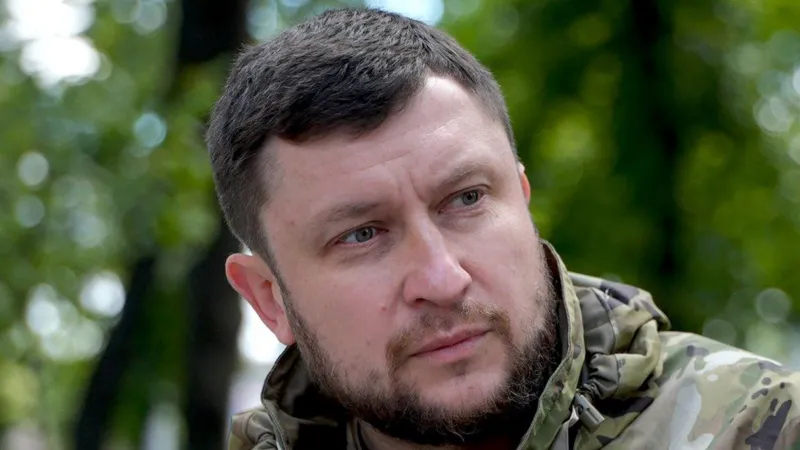The Russians simply walked in, Ukrainian troops in Kharkiv tell BBC
Denys Yaroslavskyi is angry.

As the Commander of a Ukrainian Special Reconnaissance Unit, he fought in Ukraine’s surprise offensive in Kharkiv in the autumn of 2022, which pushed back an initial Russian invasion all the way back to the border.
But now Denys and his men are facing the prospect of doing the same all over again.
Russian forces have, in recent days, made small but significant gains right along the border in the Kharkiv region.
Their advances are only a few miles deep but have swallowed up around 100km (62 miles) of Ukrainian territory. In the more heavily defended east of Ukraine, it’s taken Russia months to achieve the same.
Russia claims its forces have now entered the border town of Vovchansk, which Ukraine disputes.
The town has come under heavy bombing in recent days, and several thousand residents have been evacuated.
Denys wants to know what happened to Ukraine’s defences.
“There was no first line of defence. We saw it. The Russians just walked in. They just walked in, without any mined fields” he says.
He shows me video from a drone feed taken a few days ago of small columns of Russian troops simply walking across the border, unopposed.
He says officials had claimed that defences were being built at huge cost, but in his view, those defences simply weren’t there. “Either it was an act of negligence, or corruption. It wasn’t a failure. It was a betrayal”.
Russia has been targeting Vovchansk with artillery and glide bombs
Everyone knew that this incursion was likely to happen. Both Ukrainian and Western intelligence knew Russia had been building forces across the border – with estimates of it massing up to 30,000 troops.
President Vladimir Putin had also publicly stated his goal to create a buffer zone inside Kharkiv region to protect Russian territory from Ukrainian artillery strikes.
But Ukraine appears to have been ill-prepared - despite official denials.
Denys, speaking from a park in Kharkiv, says within an hour he’ll be back on the front line with his men close to the town of Vovchansk, just 5km (3 miles) from the Russian border.
Russian troops are already reported to have entered the edge of the town. Denys tells me he fears it could soon be back in Russian hands.
Residents of Vovchansk and nearby villages are being bussed to safety
We’d visited the town earlier, joining a local policeman, Oleksii, who was picking up residents who wanted to flee to safety. He was driving fast to avoid the Russian drones flying overhead and the constant barrage of artillery.
The population of the town before the war was around 20,000. Most had left at the start of the war, and it went down to 3,000 residents - but hundreds more have been leaving over the past few days. Oleksii says “it’s easier to leave now, before they get killed or injured”.
In Kharkiv, Russia is using all too familiar tactics to advance – reducing Ukrainian villages and towns to rubble. Oleksii estimates that Russia’s been firing around 50 to 60 shells every hour into the town. And then there’s glide bombs, fired from Russian jets tens of kilometres from the front lines, well out of range of Ukraine’s limited air defences.
Ukraine says it repelled Russian bid to cross border
Russia’s been launching around 100 glide bombs a day across the 1,000 km front. We heard half a dozen of their jet-like screeches over the course of an hour, followed by earth-shattering explosions.
Serhii’s house was destroyed by one such glide bomb. Standing in the smoking rubble he told me his wife, Svetlana, had been seriously injured. He was nursing wounds on his hands, burnt by the explosion.
He told me he’d like to leave, “but what can I do?”. He pointed to his three goats which he didn’t want to kill. Somehow, they’d miraculously survived along with his cat. Serhii was still clinging on to his final possessions.
Most of those who’ve stayed behind in Vovchansk are the elderly and the poor.
But 65-year-old Oleksandr has had enough. We watched as he made the sign of the cross, leaving the home he’d grown up in. He tenderly touched the ground, picked up two bags, and climbed into the police car.
He said he wanted to go to Germany but had no idea of how he’d get there.
Oleksandr
Opening a new front here in the north is stretching Ukraine’s limited resources. The US delay in approving more military support has starved Ukrainian troops of ammunition.
On average, Ukraine has only been able to fire one artillery round to Russia’s 10. That is now slowly being addressed, with the US support now coming.
But the Kharkiv offensive also highlights problems Ukraine itself has been too slow to address – mobilising enough troops and building adequate defence lines. Re-enforcements being sent to Kharkiv have had to be pulled from other parts of the front and limited reserves.
Ukrainian officials still insist Kharkiv city is not under threat of a ground invasion. But the further the Russian’s advance, the more likely that it will come within range of Russian artillery.
Back in a park in Kharkiv, Denys says he believes Russian forces will try to focus on the East and to capture the entire Donbas. But he says Russia is also trying to exploit Ukrainian weaknesses right across the 1,000km front. In Kharkiv they’ve found one.
“Of course I’m angry,” Denys says. “When we were fighting back for this territory in 2022, we lost thousands of people. We risked our lives.
"And now because someone didn’t build fortifications, we’re losing people again.”
-bbc






